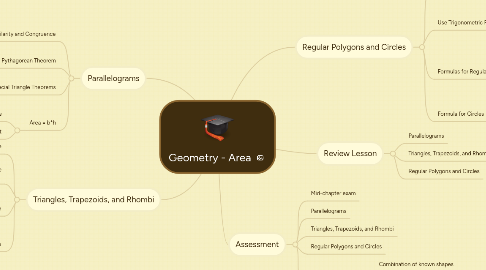
1. Parallelograms
1.1. Using Similarity and Congruence
1.1.1. Finds sides
1.1.2. Finds angles
1.2. Using the Pythagorean Theorem
1.2.1. Finds missing sides
1.3. Using Special Triangle Theorems
1.3.1. Finds sides
1.3.2. Finds angles
1.4. Area = b*h
1.4.1. b is base
1.4.2. h is height
2. Triangles, Trapezoids, and Rhombi
2.1. Triangle
2.1.1. Area = (1/2)b*h
2.2. Use previous formulas to derive Area of Trapezoid
2.2.1. Trapezoid=2 triangles
2.2.2. Area = (1/2)(b1+b2)*h
2.3. Coordinate Plane
2.3.1. Makes rhombi very simple
2.3.2. Distance formula
2.4. Rhombus
2.4.1. Area = (1/2)d1*d2
2.4.2. d stands for diagonal
3. Regular Polygons and Circles
3.1. Use the Central Angle Theorem
3.1.1. Center angle = 360/n
3.1.2. n is the number of sides in the polygon
3.2. Use Trigonometric Ratios
3.2.1. These are necessary to find missing sides
3.2.2. Can be used with any angle given that the triangle being used includes a right angle.
3.3. Formulas for Regular Polygons
3.3.1. Area = (1/2)P*a
3.3.1.1. P is the perimeter
3.3.1.2. a is the apothem, a perpendicular bisector from the center to any side
3.4. Formula for Circles
3.4.1. Area = Pi*r^2
3.4.1.1. Pi is the greek term for ~3.14
3.4.1.2. r is the radius
4. Review Lesson
4.1. Parallelograms
4.2. Triangles, Trapezoids, and Rhombi
4.3. Regular Polygons and Circles
5. Assessment
5.1. Mid-chapter exam
5.2. Parallelograms
5.3. Triangles, Trapezoids, and Rhombi
5.4. Regular Polygons and Circles
5.5. Complex shapes
5.5.1. Combination of known shapes
5.5.2. Students must use critical thinking to use appropriate formulas and solve
